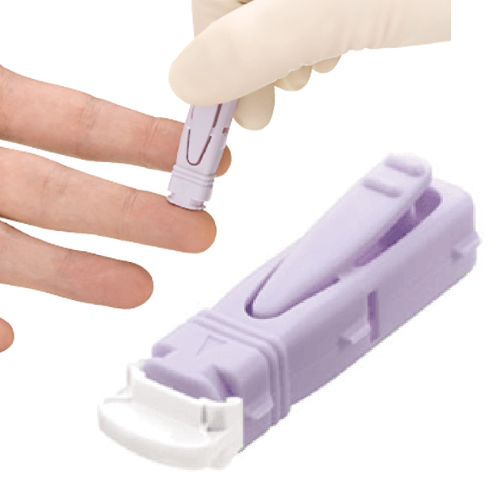A finger pricker is the term that is often used to describe the small medical device that is supplied with many home health test kits. The correct name for a finger pricker is a disposable single safety lancet. Many people call it a finger pricker as it is the device that pricks your finger to release a small amount of blood for testing.
At Zoom Health we supply a lot of home test kits. For this reason we also supply a wide range of finger prickers. Our favourite type of finger pricker is the Unistik 3 range as they are simple to use, are not painful to administer, and come in four different types:
Unistik 3 Gentle
30 Gauge Needle, 1.5mm long.
Suitable for paediatric and frequent testing.
Unistik 3 Comfort
28 Gauge Needle, 1.8mm long.
Suitable for low flow blood glucose testing.
Unistik 3 Normal
23 Gauge Needle, 1.8mm long.
Suitable for medium flow blood glucose testing.
Unistik 3 Extra
28 Gauge Needle, 1.8mm long.
Suitable for high flow blood glucose testing.
The Unistik 3 range of safety lancets feature Comfort Zone Technology, which has been shown to provide a more comfortable virtually pain-free injection in independent clinical trials.
The Unistik 3 finger pricker is extremely easy to use — simply take off the protective cap by twisting, position the lancet against the targeted spot, and press the release button. The Unistik 3 finger pricker is the most advanced, disposable safety lancet on the market.
The Unistik 3 range is colour coded for easy recognition. Unistik 3 is pre-set and ready for use. Just twist off the protective sterile cap and take the sample.
Safety lancets are quick and easy to use and fit easily into the hand. They are designed to prevent error and work quickly. Safety lancets are reasonably priced and do not require a separate lancet device.
Understanding Blood Sample Quality
Let’s face it – nobody enjoys pricking their finger. But here’s something many people don’t realise: the quality of your blood sample matters just as much as the technique. A poor sample might give you inaccurate results, forcing you to prick yourself again. Think of it like making coffee – you wouldn’t use twice-brewed grounds, would you? The key is getting enough blood the first time around. If you’re squeezing your finger too hard to get blood out, you’re actually diluting your sample with tissue fluid. That’s why choosing the right lancet depth and finger preparation techniques is crucial.
Tips To Reduce Finger Prick Pain
1. Test on the Side of Your Finger — There’s better blood flow on the sides of your finger so you should aim to test there rather than on the pad of your finger.
2. Warm Up Your Hands — get the blood flow in your fingers going by briefly rubbing them together. This should make the finger prick a little less painful.
3. Choose The Correct Lancet — The Unistik 3 range comes in four types, ranging from gentle to extra lancing, this will allow you to choose the best lancing device for your needs.
4. Don’t Use the Alcohol Wipe — alcohol is an astringent. This can make your skin tighter when you wipe it, making a blood sample harder to obtain.
5. Swap Fingers — if you are testing often, switch fingers to cut down the chances of skin scarring and calluses.
6. Use a Sharper Lancet — A finger prick with a sharper lancet will be cleaner and quicker, minimising discomfort. To keep your lancet sharp, replace it frequently.
7. Change the Depth Option — Most lancing tools offer a depth option that may be changed. Start with a lesser depth setting and progressively raise it until you hit the sweet spot between not too much discomfort and enough blood for testing.
8. Release Pressure — After you’ve pricked your finger, gently push on the surrounding region to assist ease any discomfort that may still be there. Additionally, this may aid in reducing excessive bleeding.
9. Find Distractions — While your finger is being pinched, distract yourself by doing anything that takes your mind off the pain. In order to distract yourself from the discomfort, listen to music, watch a movie, or have a discussion.
10. Practise Deep Breathing — Before and during the finger prick, take a few slow, deep breaths to calm your body and lessen pain. Take a few deep breaths through your nose, hold them for a moment, and then gently let them out through your lips.
11. Apply a Warm Compress — A few minutes before testing, apply a warm compress or a warm cloth to your finger. The blood vessels are widened by the warmth, lessening the discomfort of the finger poke.
12. Apply a Numbing Cream — Take into account utilising a numbing gel or cream made especially for finger pricks. These topical anaesthetics can numb the region momentarily, lessening the discomfort brought on by the finger prick.
13. Keep Blood Sugar Levels Proper — High blood sugar levels might make your fingertips more sensitive, making a finger prick more painful. You may lessen the discomfort from a finger prick by successfully controlling your blood sugar levels.
14. Rotate Testing Locations — Testing on the same finger over time might enhance sensitivity and cause calluses. To lessen discomfort and avoid skin injury, rotate testing locations often while using various fingers.
15. Seek Professional Advice — If, despite using these suggestions, you still suffer significant discomfort during finger pricks, speak with your healthcare professional. They might be able to propose different methods or other tools that might assist lessen the discomfort brought on by finger pricks.
Photo by Anthony Cunningham for Zoom Health
Zoom Health is a leading UK supplier of Home Health Tests and Earplugs
This post was originally published in 2017. It was last updated in July 2023.





